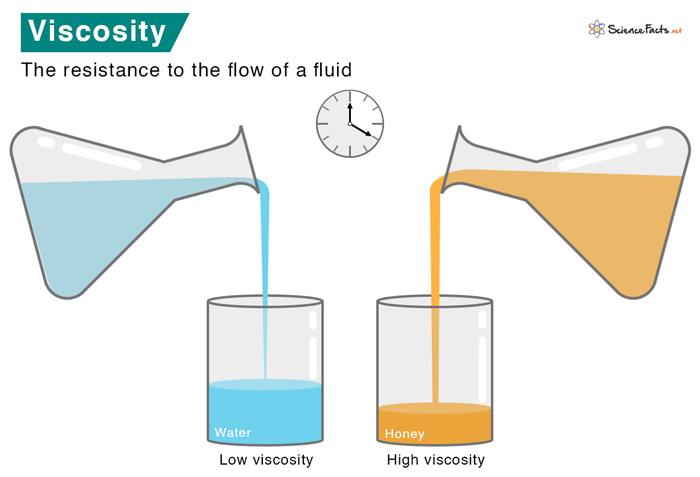High Viscosity vs. Low Viscosity
Dynamic and Kinematic Viscosity
Formula
Factors Affecting Viscosity
Newtonian and Non-Newtonian Fluid
Examples High-viscosity fluids include honey, pitch, molten glass, and peanut butter; low-viscosity fluids include air and water. Two fluids having the same dynamic viscosity can have different kinematic viscosities. The reason is that kinematic viscosity depends on the density of the fluid. On the other hand, density is not a factor with dynamic viscosity. Since viscosity measures the resistance of a fluid deformed by shear, it is expressed as the ratio of the shear stress to the velocity gradient. Where η is the dynamic viscosity F is the applied force A is the area over which the force is applied ∂u/∂y is the velocity gradient The above equation was derived by British mathematician Isaac Newton and is called Newton’s law of viscosity. It is applicable for straight, parallel, and uniform flow. The term u/v is the shear rate of deformation, and du/dv is the shear velocity. Kinematic Viscosity The ratio of the dynamic viscosity and fluid density gives the kinematic viscosity. Where ν is the kinematic viscosity η is the dynamic viscosity ρ is the density
Symbols and Units
Dynamic Viscosity Greek symbol mu (μ) or eta (η) represents dynamic viscosity. Its SI unit is Pascal-second or Paˑs, equivalent to Nˑs/m2 or Paˑs. The cgs unit is poise or P. ASTM standard uses centiPoise or cP. 1 P = 0.1 Paˑs and 1 cP = 0.001 Paˑs Kinematic Viscosity Greek symbol nu (ν) represents kinematic viscosity. The SI unit of kinematic viscosity is m2/s. The cgs unit is Stokes or St. It is sometimes expressed in centiStokes. 1 St = 10-4 m2/s and 1 cSt = 10-6 m2/s
Viscosity Chart
Viscosity is measured using a viscometer. The following table gives the viscosity values of some common substances. Chart Courtesy: Innovative Calibration Solutions The viscosity of gases is approximately proportional to the square root of temperature. The reason why gases increase their viscosity is because of an increased frequency of collisions. The more the molecules collide, the more disorganized they become. As a result, they move sluggishly. Intermolecular forces in a fluid are a factor that affects viscosity. The higher the intermolecular forces, the higher the viscosity. Due to strong intermolecular forces, the fluid molecules are strongly bonded to each other. As a result, they are prevented from moving. On the other hand, if the viscosity does not remain constant and depends on the force applied, the fluid is called non-Newtonian fluid. The viscosity changes as shear stress is applied. Examples include slime, toothpaste, cosmetics, and paints.

